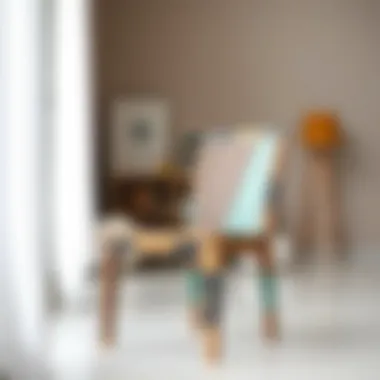Exploring the Market for Second-Hand Tables and Chairs


Intro
The vibrant world of second-hand tables and chairs beckons homeowners, decorators, and all who appreciate distinct aesthetics. This market, often seen as a treasure trove, offers not just furniture but stories and individuality, all while fostering sustainability. In changing times, where eco-consciousness is ever-growing, the allure of pre-owned furniture radiates charm and character.
As you step into this realm, it's important to understand not just what you buy but also why it matters. From alleviating environmental strains to enhancing financial savvy, choosing second-hand pieces reflects a lifestyle choice that favors sustainability over fleeting consumerism. And let's be honest—the appeal of finding that unique piece, often at a bargain, adds a thrill akin to hunting for buried treasure.
Inside this exploration, we will journey through various furniture styles, current trends, and practical tips for selection. You may be wondering, how does one sift through the mountains of options? What should one look for to ensure quality while optimizing the use of space? Fear not; insights await to guide you.
Through detailed analysis, we'll sketch a roadmap to successfully navigate the second-hand market. Whether you're curating a cozy nook in your home, outfitting a professional space, or simply looking to refresh your interior, understanding the ins and outs will illuminate your path. Everyone deserves a space that resonates with their style, and sometimes, the most intriguing items are those with a past.
Are you ready to dive into the nuances of this evolving market? Let's unravel the fascinating chapter of furniture styles and trends.
The Appeal of Second-Hand Furniture
The allure of second-hand furniture, especially tables and chairs, cannot be overstated in a world increasingly focused on sustainability. With a myriad of benefits like cost savings, unique aesthetics, and a redemptive environmental impact, many homeowners and designers are turning their gaze to pre-owned pieces. This section delves into these factors, prompting a deeper appreciation for why second-hand furniture is not just an alternative but an appealing choice for many.
Understanding the Environmental Impact
When it comes to furniture, sustainability is not just a buzzword; it’s a waking reality. Each second-hand chair or table saved from a landfill translates into less waste and lower carbon emissions. The production of new furniture often entails heavy resource consumption, from trees felled for wood to materials processed in factories. Thus, opting for pre-owned items helps to reduce this demand for new manufacturing. It’s like choosing the road less traveled, where each unique piece carries a history, often giving off its own character that cannot be found in mass-produced counterparts.
Incorporating second-hand finds into your home also contributes to the circular economy, extending the lifespan of beautifully crafted items. For instance, vintage wooden chairs that have been gently used can still sit proudly at your dining table but with fewer environmental costs than their brand-new counterparts. When you ultimately decide to part with them, they can be passed along again, continuing their story.
Cost-Effectiveness in Home Furnishing
In the era of sky-high prices for new furnishings, one cannot ignore the financial benefits of diving into the second-hand market. Picture this: A set of chic chairs at a hefty price in a retail store versus a beat-up pair of vintage chairs in a local thrift shop. What if you could give that old set a makeover? By investing a fraction of the cost, you open a world of possibilities.
Here’s how the budget can stretch further:
- Immediate savings: Second-hand items often come at significant markdowns compared to their brand-new equivalents. Why pay full price for a name when you can have something with personality at half the cost?
- Investment potential: Furniture trends ebb and flow, much like fashion. Pieces purchased for less can appreciate in value; think of mid-century modern pieces that are now highly sought after.
- Flexibility: When you buy used, the stakes are lower. You can experiment with styles without the typical financial burden - if you don’t love a piece, it’s less regretfully spent.
Unique Aesthetics of Pre-Owned Items
There’s something intrinsically appealing about second-hand furniture. The unique styles inherent in pre-owned items offer a charm that modern pieces often lack. Each dent, scratch, or uneven edge tells a story. It's as if they have a personality – a history that whispers tales of the past.
Consider this: A worn-out oak table can serve as the centerpiece of a home, juxtaposed beautifully against sleek modern stools. Individuals can blend eras and styles, creating a living space that feels comfortably lived-in and expressive. It’s about curation, as you sift through countless options to uncover gems that reflect your tastes. Those findings foster a bespoke atmosphere that no assembly line can replicate.
In essence, choosing second-hand furniture opens the door to a treasure trove of possibilities. With strong environmental benefits, significant cost-effectiveness, and an eye-catching aesthetic, it’s hard to ignore the appeal of these treasures from the past.
Purchasing second-hand isn't just a thrifty choice; it's a forward-thinking resolution for both your wallet and the planet.
Identifying Quality: How to Evaluate Second-Hand Tables and Chairs
When it comes to second-hand furniture, particularly tables and chairs, knowing how to gauge quality can be the difference between a great buy and a complete disaster. Many folks may underestimate this aspect, thinking that as long as it's cheap and looks good, it’s golden. But that's far from the truth. Furniture that's well-built can withstand the test of time, while poorly made items may fall apart after a few uses. Therefore, understanding how to evaluate the quality of second-hand tables and chairs is crucial for ensuring longevity, safety, and satisfaction in your investment.
Materials and Durability
The materials from which a piece of furniture is made are paramount in determining its durability. Solid wood, for instance, is often a sign of quality; oak, walnut, and cherry are typical staples known for their toughness. Unlike particle board or MDF, which might break or warp over time, solid types can endure daily wear and tear while providing good support.
- Look closely at the grains: Tight grains usually mean better quality wood. If you see a large gap or it feels flimsy, you might want to skip that one.
- Test it out: Put weight on the chair or shake the table gently. If it feels sturdy and doesn’t wobble, you're likely on the right track.


And don't forget about coatings or finishes. A finish that’s peeling is a sign of neglect, or worse, poor construction. If it's made from synthetic materials like plastic, consider how it’s aged. A well-kept synthetic piece can still serve its purpose, but visibly cracks or chips should raise red flags.
Signs of Wear and Tear
Not every scratch is a deal-breaker, but identifying the right signs of wear and tear can help you gauge whether an item is truly worth your cash. Wear can tell you a lot about how much love (or neglect) a piece has seen over the years.
- Check for wobbles: A wobbly chair might indicate a fault in its construction, maybe the legs are uneven or not attached securely.
- Look for upholstery damage: Tears, stains, and smells can imply that it might need more than just a good cleaning. If the fabric looks old, it's worth considering how comfortable you'll feel sitting on it.
- Inspect the joints and fasteners: Loose screws or nails could lead to instability. If you notice parts coming apart, ask yourself whether it’s worth the effort to repair.
Detecting these signs early can save you from buying something that inevitably becomes a headache.
Brand Reputation and Craftsmanship
Certain brands have established themselves as leaders in quality and design in the furniture market. Knowing which ones to look for—or avoiding—can enhance your chances of snagging a gem.
- Research brands: Familiarize yourself with brands known for their craftsmanship. Companies like Stickley and Herman Miller are often synonymous with quality. However, just because a piece has a renowned name doesn’t mean it’s automatically a good find; always inspect it personally.
- Look for maker’s marks: Many high-quality pieces will have a label or engraving that speaks to their authenticity. It can shed light on the craftsmanship and even the era it was made.
- Evaluate the design aesthetics: Quality furniture often embraces timeless design over fleeting trends. If something feels trendy, it might lack the endurance required to stand the test of time.
Where to Find Second-Hand Tables and Chairs
Finding the right place to acquire second-hand tables and chairs is pivotal in creating a living space that's both functional and reflective of personal taste. Shifting to pre-owned furniture offers an opportunity to snag unique pieces while being eco-friendly and budget-conscious. As home decor trends evolve, the hunt for distinct styles can lead to unexpected finds that tell a story.
Local Thrift Stores and Flea Markets
Local thrift stores and flea markets can often feel like treasure troves packed tightly with forgotten gems. The beauty of shopping here lies in the thrill of discovery; you might walk in thinking you need a simple dining chair, only to stumble upon a stunning mid-century table that becomes the centerpiece of your room.
Thrift stores generally change their inventory frequently, so regular visits can pay off. Unique finds aren’t just limited to aesthetics; the prices tend to be attractive as well. Often, common budget constraints push buyers towards these outlets where quality and style can align seamlessly without breaking the bank. However, patience is key. While you may not find your ideal piece during the first visit, you’re bound to discover something surprising the more you browse.
Online Marketplaces: A Comprehensive Evaluation
Online marketplaces have transformed the way people shop for second-hand furniture, making it easy to search for specific items right from home. The convenience of filtering searches through various parameters such as style, price, and location is valuable for homeowners and decorators alike.
Popular Platforms for Second-Hand Furniture
Several online platforms cater specifically to the second-hand market, such as Facebook Marketplace, Craigslist, and OfferUp. Each of these platforms has carved its own niche within the second-hand community.
- Facebook Marketplace: Often touted for local listings, it’s an excellent option for connecting with sellers nearby. Users frequently share photos, which can aid in assessing the condition before making a visit. The integrated messaging feature is also useful for negotiating prices.
- Craigslist: While it has been around for a while, Craigslist remains a key player due to its wide reach. It's like rummaging through a digital flea market every day.
- OfferUp: This app offers a neat, user-friendly interface. Users can rate sellers, which adds a layer of security to transactions, helping transactions feel more trustworthy.
The key characteristic of these platforms is accessibility; anyone can post or shop, making the market vibrant and diverse. However, caution is warranted. Always prepare to evaluate listings carefully and consider meeting in public spaces.
Tips for Safe Transactions Online
Safety during online transactions is paramount. Here are some practical tips to help navigate the second-hand waters:
- Verify the Seller: Check reviews or ratings if available. A good reputation can alleviate some anxiety about the purchase.
- Meet in Public: Arrange to meet the seller in a safe, public location, like a coffee shop or a community center, especially if it's the first exchange.
- Inspect Before Paying: Always inspect the piece before handing over cash. Look out for any flaws or damages that weren’t noted in the listing.
- Use Cash or Mobile Payments: Where possible, secure payments via cash or trusted apps to avoid complications down the line.
Following these tips can minimize the risks involved in purchasing second-hand furniture online and protect your investment.
Community Sales and Estate Auctions
Finally, community sales and estate auctions are noteworthy for those who relish a good hunt. These events can yield high-quality pieces that may not be easily found elsewhere. Often, estate sales offer unique, curated collections of furniture that often carry historical or sentimental value. Attendees at these events tend to form a tight-knit community. Engaging with fellow buyers can lead to tips on upcoming sales, deepening the experience and building connections in addition to home decor expertise.
Restoration and Maintenance of Second-Hand Items


When diving into the world of second-hand furniture, restoration and maintenance are crucial topics that often shape the longevity and usability of these pre-owned treasures. As much as folks appreciate the aesthetic charm of a vintage table or a quirky chair, ensuring that these pieces are in good working order can dramatically enhance their value and functionality in any space. This section will explore why restoration and maintenance should be a priority for buyers looking to integrate second-hand furniture into their homes.
One essential aspect of restoration lies in its ability to breathe new life into forgotten items. A well-restored piece not only retains the character inherent in its design but can also provide a sense of history and uniqueness. This is something that mass-produced items often lack. Practicing good maintenance habits contributes to long-term cost savings, as regular care can avoid expensive repairs down the line.
Refinishing Wooden Surfaces
Refinishing wooden surfaces is often one of the first steps in restoring a second-hand furniture piece. This process involves sanding down the existing finish, repairing any deeper scratches or dents, and applying a new layer of finish. One major benefit of refinishing is that it allows you to customize the appearance of the furniture, whether by selecting a new stain or a protective coat. This adaptability is particularly appealing for homeowners looking to fit pieces into their existing decor.
However, the process requires the right tools and some level of skill. While anyone can theoretically attempt it, understanding how to properly sand and finish wood is key. Messing this up could lead to uneven surfaces or further damage, which is why some choose to hire professionals for particularly valuable pieces.
Repairing Upholstery: When to DIY
Upholstery repair is another significant consideration when looking at second-hand chairs or benches. Many might wonder when to dive into DIY upholstery projects. Firstly, if the damage is minor—like a small tear or frayed edges—you might save some cash by tackling it yourself. For those on a tight budget, basic upholstery techniques can breathe new life into a chair.
Basic Upholstery Techniques
Basic upholstery techniques typically involve a few straightforward measures, such as re-stapling or recovering cushions. These methods can often be learned via online tutorials and videos, which makes them accessible for those looking to hone their skills. What’s great about these techniques is that they don’t require an extensive toolkit; even a staple gun and some fabric can go a long way.
- Key Characteristics of Basic Upholstery Techniques
- Affordability: Many basic techniques can be done with minimal expense.
- Accessibility: Tutorials and resources are widely available.
- Satisfaction: Successfully completing a DIY upholstery project brings a rewarding sense of accomplishment.
However, if the chair has extensive damage or a complex design, it might be wiser to seek professional help. Attempting to fix deeply stained or structurally compromised upholstery can often lead to less satisfactory results.
Choosing the Right Fabric
Another critical consideration in upholstery repair is choosing the right fabric. Selecting a fabric that complements your home must align with your overall aesthetic and durability needs. Fabrics such as canvas or denim provide a sturdy option for high-use items, while lighter fabrics may suit decorative pieces better.
- Key Characteristic of Choosing the Right Fabric
- Durability: Choosing the right fabric affects the longevity of your upholstered piece.
- Aesthetic Appeal: The chosen fabric should align with your design objectives.
- Maintenance: Some fabrics are easier to clean than others, which should factor into your decision.
When pondering fabric selection, consider the unique features it brings to the table. A high-quality fabric with excellent color retention can elevate any piece but might come with a heftier price tag.
In summary, restoration and maintenance of second-hand tables and chairs allow individuals to customize their furniture to suit their tastes and needs. By investing time and thought into both refinishing wood and properly selecting upholstery, buyers can enhance the functional and aesthetic value of their second-hand finds, transforming them into focal points of the home.
The Trends in Second-Hand Furniture Market
Understanding the current trends in the second-hand furniture market is crucial for anyone looking to invest in pre-owned tables and chairs. It reflects not only evolving consumer preferences but also wider societal shifts towards sustainability and economy. As people grow more aware of the environmental implications of their purchasing decisions, the second-hand market attracts attention. This section serves to illuminate how the trends are shaping up and why they matter.
Shifts in Consumer Preferences
Today, buyers are often on the lookout for uniqueness. Instead of opting for brand new, cookie-cutter items, many homeowners are drawn to the idea of owning something with a story or character. Vintage finds have gained traction; this means that even simple tables or chairs can impart a sense of history, making them desirable. The idea of personalization also shines here. When people incorporate second-hand furnishings, they add their own touch, creating an environment that reflects their personality rather than a mass-produced aesthetic.
- Practical Needs: Many people now aim for functionality and versatility in their furniture choices. If a used table can serve multiple functions, it weighs heavily on the decision to purchase.
- Budget Awareness: With inflation pushing up living costs, more consumers prefer buying second-hand to stretch their budgets. This change has blurred the lines between frugality and style.
People often engage in what’s known as "conscious consumerism," where their choices stem from an understanding of their purchase’s impact. As this mindset grows, the market for second-hand furniture expands, driven by an increasingly mindful consumer base.
Sustainability as a Key Driver
One of the most compelling trends is the strong emphasis on sustainability. As climate awareness increases, more individuals are looking for ways to lessen their environmental footprint. Purchasing second-hand furniture is one concrete step in this direction. Not only does it slow down the demand for new pieces—thus minimizing manufacturing waste—but it also aids in keeping still-functioning items out of landfills.


- Resource Conservation: The act of reusing contributes directly to preserving natural resources. By buying pre-owned, consumers actively participate in reducing the carbon footprint associated with new furniture production.
- Eco-Friendly Practices: Many brands and stores have started to align themselves with eco-friendly practices, catering to environmentally-conscious shoppers. For instance, retailers promote circular economy principles, thereby fostering an environment where reusing is normalized.
"Sustainability isn't just a trend for some; it's an essential lifestyle choice that guides everyday decisions."
To sum up, shifts in consumer preferences toward unique finds and an amplified focus on sustainability have had significant implications for the second-hand furniture market. Understanding these trends is not merely about knowing what’s popular; it’s about recognizing the values driving those choices and embracing the ingenuity that comes with a more sustainable, reimagined approach to furnishing our homes.
Challenges in Purchasing Second-Hand Furniture
When it comes to picking out second-hand tables and chairs, there are a few bumps in the road that every buyer should be aware of. Understanding these challenges can help you make informed decisions that not only save you money but also ensure you bring home quality pieces that enhance your living space.
Navigating Pricing Discrepancies
The pricing of second-hand furniture can sometimes feel like a wild goose chase. One seller might think their used table is worth a king's ransom while another sees it as just salvage material. This discrepancy, however, can provide both an opportunity and a challenge for savvy shoppers.
- Research is Key: When eyeing a piece, delve into what similar items are priced at online. Websites like Facebook Marketplace or Craigslist often have comparable listings that will give you a fair idea of a reasonable price.
- Condition Counts: Evaluate the state of the item closely. If a chair has seen better days but is still structurally sound, it may go for less than its value. Understanding the difference between cosmetic flaws and functional issues can give you a bargaining chip when haggling with the seller.
- Contextual Knowledge: Sometimes, geographical location and local demand can drastically shift prices. Items in urban areas might reflect a higher demand, leading to inflated prices, whereas rural finds might be priced more affordably.
Overall, a keen eye combined with a touch of patience can help ensure you don’t overpay, allowing you to snag hidden gems.
Identifying and Avoiding Scams
Unfortunately, the world of second-hand goods isn’t without its fair share of unsavory characters. Recognizing the signs of potential scams can save time, hassle, and money. Here’s how you can protect yourself:
- Meet in Safe Locations: For in-person transactions, arrange to meet in public places, away from your home. Coffee shops or community centers are great options.
- Ask for More Photos: If an online listing has only one image, ask for more. A lack of visuals can often be a red flag indicating something's not right about the item.
- Trust Your Instincts: If a deal seems too good to be true, it might be. A classic example is someone selling a high-end table for a fraction of its worth. Be cautious and consider if the deal feels off.
- Payment Methods Matter: Opt for payment methods that provide buyer protection. Avoid wiring money or using services that don’t offer any assurance against fraud.
Being proactive and cautious will go a long way in ensuring your second-hand shopping experience is a safe one.
Understanding Return Policies
One of the trickiest parts of buying second-hand furniture is the lack of a solid return policy, which is often absent with individual sellers. Unlike retail stores that provide peace of mind with returns, pre-owned purchases come with their own set of uncertainties. Here’s what to consider:
- Communicate Before You Buy: If there is a chance you might want to return the item, have that conversation upfront. Understand whether the seller is open to returns, or if they have a strict no-returns policy, which is common in private sales.
- Consider Your Needs: If you’re not sure about a particular style or fit in your home, it might be wise to keep your options open. Only buy what you’re confident about unless you're prepared for the potential of not being able to return it.
- Documentation: If you manage to establish some kind of return agreement, get it in writing, even if it's just a text message. This helps protect you in case things go south.
In the whirlwind world of second-hand furniture buying, being aware of these challenges won’t just help you navigate through rough waters, but practically steer you toward making choices that are both savvy and satisfying.
Incorporating Second-Hand Furnishings into Home Decor
In the journey of transforming a house into a home, incorporating second-hand furnishings offers a unique blend of character, history, and affordability. This topic arises not only from a growing awareness of sustainability but also from a desire for individuality in home decor. When you choose pre-owned tables and chairs, you’re not just picking out furniture; you're telling a story. Each scratch and bump can evoke memories and conversations. Moreover, in a world where cookie-cutter furniture sets dominate, second-hand pieces stand out as distinctive choices, adding layers of personality to any room.
In addition to being eco-friendly, the economic benefit of purchasing second-hand items cannot be overstated. With rising prices for new furniture, seeking out pre-owned options allows homeowners to decorate their spaces beautifully without breaking the bank. However, it’s important to embrace the principles of mixing styles and ensuring cohesiveness in your decor to prevent a chaotic arrangement that undermines your overall design vision.
Mixing Vintage and Modern Styles
Combining vintage and modern elements can create a distinct and dynamic ambiance within your space. The charm of vintage furniture—its craftsmanship, design, and stories— can counterbalance the sleek and sometimes sterile nature of contemporary pieces. This blend invites warmth and interest while reflecting different eras and styles.
Here are few tips to successfully mix vintage with modern:
- Choose a Dominant Style: Pick which style you want to dominate the space. For instance, if modern is the primary style, select vintage pieces with clean lines and simple forms to complement it smoothly.
- Color Palette Coordination: Match colors across your furnishings. If your modern chairs have muted tones, seek a vintage table that shares similar hues or has an accent that ties it together.
- Layering Textures: The beauty of incorporating items from varied times lies in contrasting textures. Combining soft fabrics from vintage chairs against sleek metal from modern tables adds richness and depth to your decor.
- Statement Pieces: Allow a vintage piece to be a focal point. This could be an intricately carved wooden chair or a mid-century side table. It draws attention and serves as a conversation starter.
By following these guidelines, you'll create a delightful space that feels curated yet spontaneous, combining bygone charm with modern flair.
Creating a Cohesive Look
Creating a cohesive look when decorating with second-hand furnishings hinges on thoughtful selection and placement. Even when mixing styles, elements should harmonize to avoid visual chaos. Here’s how to achieve that balance:
- Shared Design Elements: It helps to select items that share similar shapes or motifs even if their designs are different. A round, modern dining table paired with vintage round chairs can unify the space.
- Limit Your Color Palette: Stick to three or four key colors for your room to ensure everything feels tied together. This allows your vintage finds and modern pieces to play well together and not fight for attention.
- Use Area Rugs: Rugs can ground your decor and bring distinct pieces into a shared space. A vintage Persian rug under a modern coffee table can act as a bridge between different styles.
- Accent Pieces: Incorporate accessories such as cushions, artwork, or lamps that feature a blend of styles. This can subtly echo the mix of vintage and modern you’ve achieved throughout the room.
"Designing your space with second-hand pieces is more than just an aesthetic choice; it's a chance to create a narrative that resonates with both past and present."















